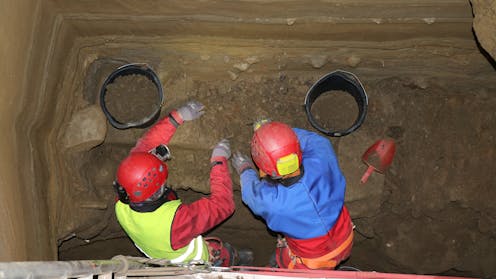Our DNA analysis of 75,000-year-old bones in Arctic caves reveals how animals responded to changing climates
Scientists excavating bones in Arne Qvamgrotta, a cave in the Norwegian Arctic. Trond Klungseth Lødøen, CC BY-NC-ND
As the Arctic warms faster than anywhere else on Earth, animals that have evolved to survive the cold face unprecedented challenges. While scientists are learning more about how modern wildlife responds to environmental change, we still know little about how species coped in the past.
Our new study investigates the oldest-known diverse animal community from the European Arctic, dating back 75,000 years. Preserved deep inside a cave in northern Norway, it offers a rare insight into how Arctic ecosystems functioned during a slightly warmer phase of the last ice age.
The Arctic region underwent repeated advances and retreats of glacial ice throughout the last ice age (118,000-11,000 years ago) – a sequence of colder full-glacial conditions (stadials) and warmer phases (interstadials), during which the glaciers retreated to higher elevations. These fluctuating conditions resulted in successive migrations and retractions of animals and plants, eventually shaping the animal communities we see today.
A consequence of being in a glacially active area is that sediment deposits are easily destroyed, as glaciers carve across the landscape and meltwater flushes the caves bare. This has left very few records of the animals and ecosystems prior to the end of the last ice age, around 11,000 years ago.
But remarkably, one sediment deposit has survived intact for more than 75,000 years within Arne Qvamgrotta, a branch off the larger Storsteinhola karst cave system in Norway.
This cave is tucked just within the Arctic Circle in the shadow of Norway’s national mountain, Stetind, on the outskirts of the small coastal town of Kjøpsvik, Nordland. The region is home to thousands of karst caves formed through water dissolving the underlying bedrock, resulting in a dramatic and breathtaking landscapes both above and below ground.
The sediment profile in Arne Qvamgrotta, Norway, after excavation.
Trond Klungseth Lødøen, CC BY-NC-ND
The intact sediment deposit with preserved bones in Arne Qvamgrotta was first discovered in the early 1990s, during industrial mining activity for limestone. In 2021 and 2022, our team – led by the University of Oslo – returned to the cave to explore these sediments and excavate and recover bone material, to better understand the species diversity in this unusual deposit. Our analyses provide a rare ecological snapshot of the last ice age.
We recovered more than 6,000 bone fragments, on which we used comparative osteology (comparing bone shape and structure to identify species) and ancient-DNA metabarcoding (identifying fragmented bones by analysing DNA strands and matching them to a database of species). Using these techniques, we identified 46 different kinds of animal (to family, genus and species levels) including mammals, birds and fish living both on land and in the sea.
These species include the third-oldest polar bear ever discovered, plus walrus, bowhead whale and seabirds such as king eider and puffin. We found fish including the Arctic grayling and Atlantic cod. One of the most important finds is the now-regionally extinct collared lemming, an animal not previously been identified in Scandinavia.
Researchers found this well-preserved polar bear vertebra during the cave excavation.
Trond Klungseth Lødøen, CC BY-NC-ND
We used various dating techniques that show the bones are around 75,000 years old – dating back to a slightly warmer (interstadial) phase of the last ice age.
The animals we found show that, during this time in this part of Norway, the coastal land was ice-free – enabling the easy northward movement of migratory reindeer and freshwater fish, for example. We also found a rich mix of marine and coastal animals that support the presence of seasonal sea ice.
This animal community is distinctly different from the most commonly found ice-age megafauna. These include the woolly mammoth and musk ox that are typically associated with the mammoth steppe – the cold, dry grasslands that stretched across much of Europe, North America and northern Asia during the last ice age.
This difference probably reflects the unique coastal setting and landscape surrounding Arne Qvamgrotta, which would have supported a different kind of ecosystem.
Further ancient-DNA analyses from some of the bones reveal that the lineages of the polar bear, collared lemming and Arctic fox from this time and place are now extinct. This suggests these animals could not follow the changing habitats or find refuge during later cold periods of the last ice age – highlighting how vulnerable nature can be under changing climate conditions.
Don’t have time to read about climate change as much as you’d like?
Get a weekly roundup in your inbox instead. Every Wednesday, The Conversation’s environment editor writes Imagine, a short email that goes a little deeper into just one climate issue. Join the 45,000+ readers who’ve subscribed so far.
Samuel Walker receives funding from the British Academy.
Sanne Boessenkool receives funding from The Research Council of Norway.



